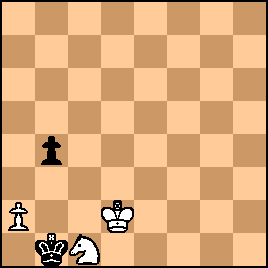| keypusher: As NM JRouselle and Edward Lasker <Chess Secrets I Learned From the Masters> pointed out, 31.f4 was winning. Even though White winds up a pawn down after 31.f4 Ne2+ 32.Kf2 Nxf4 33.Kf3 Rxe5 34.Kxf4 Re2 35.h4 Rxb2 36.Rxd3 Rxa2, he wins easily because his pawns are further advanced. After 31.Nxd3 Rxg4+ Lasker forged on through a long tricky ending, reaching this position: 
click for larger viewRotlewi had just played 57....Ke7-f8, Lasker explains, <To give me as few checking opportunities as possible.> Lasker played 58.Na7 (Oh rashness of youth! he writes), and Rotlewi forced an immediate draw with 58....b4 59.Kd4 c3 60.bxc3 Ne6+! 61.Kc4 bxc3 62.Kxc3 Nxf4. In this book, Lasker says that he had two plans he could have tried: (1) to try to force the f-pawn through (2) to let the f-pawn go and attack the black pawns with his king and knight. The first would not have worked, he says, supplying the following variation: 58. f5 Nd3+ 59. Ke6 Nxb2 60. Ne5 Nd3 61. Nd7+ Kg8 62. f6 Nf4+ 63. Ke7 Ng6+ 64. Ke8 c3. White's knight has to retreat to b3 to guard the queening square, while the Black knight guards <White>'s queening square. If White's king goes after the black pawns, Black takes the f-pawn and the N+P v. N ending is an easy draw. What he should have done, Lasker writes, is go after the Black q-side pawns while guarding his own: 58.Kd4 Nd3 59. Kc3 Nxf4 60. Na7 Ne2+ 61. Kd2 Nd4 62. a3 and both pawns, Lasker writes, will fall after 63.Kc3. But as the meme goes, <Isn't there someone you forgot to ask?> Stockfish spoils the story: 62....Nb3+ 63.Kc3 Nc5 64.Nxb5 Na4+ 65.Kc2 Ke7 
click for larger viewWhat can White do? Pushing the b-pawn is an instant draw, and the White king can't approach the black pawn. 66.Nc3 Nb6 67.a4 Kd6 68.a5 Na8 69.Ne4+ Kc6 doesn't get White anywhere. Lasker's winning line doesn't win. But back up, SF says: 58.Kd4 Nd3 59.Na7, and if 59....Nxf4 60.Nxb5 Nd3 61.a4 Nxb2 62.a5 and White's king, knight and pawn are going to overpower Black's knight: 62....Nd3 63. Kxc4 Ne5+ 64. Kd5 Nd3 65. Kd6 Nb4 66. Kc5 Nd3+ 67. Kb6 Nb4 68. Nc3 Ke7 69. Kb5 Nc2 70. a6, etc. Nor does 61....b4 62.Nc6 Nxb2 Nxb4 work, since Black's last pawn will soon fall. SF also finds another win at move 58: Nd4 Nd3+ 59. Ke4 Nxb2 60. Nxb5 Ke7 61. Nc3 Nd3 62. Nd5+ Kd6 63. Kd4 Nb2 64. Nc3 Ke6 65. a4 and White will queen a pawn, with or without winning the Black c-pawn in the process. But why do these lines work? Because Black's king is either late to the fray or doesn't show up at all. And why is that? Because Rotlewi stuck it on f8 <To give me as few checking opportunities as possible>(??). If instead 57....Kd7, the engine suggests, the game is drawn. For example: 58.Nd4 Nd3+ 59.Ke4 b4 60.b3 (a clever winning attempt, now that Nc6 is unplayable) 60....Kd6! and if 61.bxc4 
click for larger view61....Nxf4!! 62.Kxf4 Kc5
Believe it or not, that's a draw. For example: 63.Nb3+ Kxc4 64.Ke3 Kc3 65.Nc1 Kb2 66.Kd2 Kb1! 
click for larger viewThe pawn can't move, the knight can't abandon the pawn, the king can't abandon the knight. The defense works, of course, because the Black king is active. Put it on f8 as in the game, and 58.Nd4 Nd3+ 59.Ke4 b4 60.b3 Nc1 61.bxc4 Nxa2 62.c5 and White will win. The ending was probably drawn all the way from 31.Nxd3(?) to 57....Kf8(?). I'm really enjoying Lasker's work. He lived a very interesting life around interesting people. And <Chess Secrets I Learned From Stockfish> would probably not sell a lot of copies. But it would be a damned good book. | 




